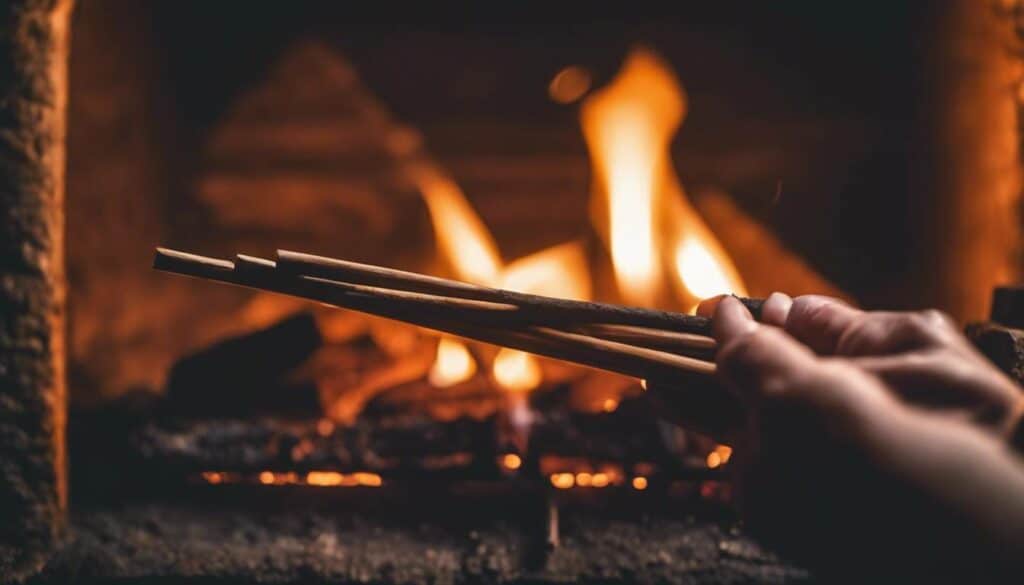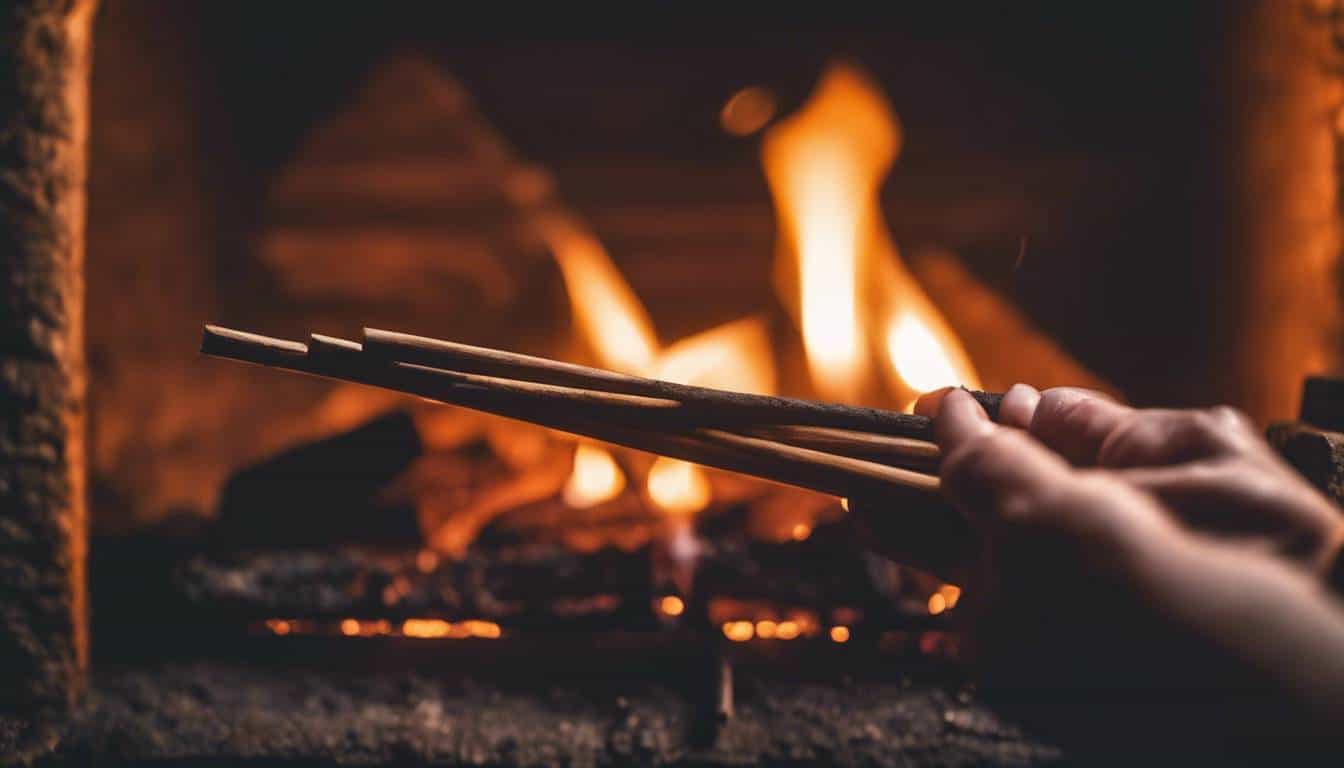As someone who cherishes cozy evenings at home, I’ve perfected my own methods for safely and efficiently lighting a wood stove, ensuring warmth and comfort throughout the night. First, ensure your wood stove is clean and ready. A stove free of ash and debris not only operates better but also eliminates possible hazards like blocked airflow. But before you strike that match, don’t overlook the importance of dry, seasoned wood – a detail often missed by many. High-quality wood can significantly improve your stove’s performance. With these steps in mind, you’re all set to go about cleaning your stove’s interior.
To light a wood-burning stove, gather kindling, larger logs, matches, and paper. Open the damper to allow airflow, place kindling in the center of the stove, and arrange small pieces of dry wood around it in a tent or tepee shape. This method is particularly effective for log burners without chimneys, which require careful attention to airflow. Once ignited, add larger logs while ensuring adequate air circulation, then adjust the damper according to your desired heat output. Always ensure that materials burned are safe and appropriate for use in the stove.
Prepare Your Wood Stove for Lighting
Before starting a fire in your wood-burning stove, it’s crucial to prepare the stove properly. First things first, you’ll need to give the interior of your stove a good clean to remove any leftover ash or debris from previous use that could potentially block the flue or chimney and impede proper airflow. This preparation is equally important for gas fireplaces, which also require regular maintenance for optimal performance.
Cleaning the stove interior is vital for maintaining efficient burning and preventing build-up that could cause damage over time. A dirty stove interior can impact its performance and pose safety risks. So, this step is not one to overlook.
Next, you’ll want to ensure that the air vents on your stove are fully open. This is crucial for allowing proper oxygen flow, which is essential for the combustion process when lighting the fire.
Without enough oxygen, the fire may not ignite properly, leading to poor burning efficiency and increased smoke production within your home. By ensuring that the air vents are open, you create an optimal environment for achieving a clean and efficient burn.
Proper airflow is key to reaching high temperatures quickly and efficiently, resulting in less smoke and fewer harmful emissions. This not only benefits the environment but also contributes to the longevity of your stove by minimizing creosote build-up, reducing maintenance requirements, and potentially extending the lifespan of your chimney system.
Once you’ve checked the air vents, consider adding a thin layer of ash to the firebox before starting the fire. This layer can help with insulation and provide a stable base for arranging kindling and firewood.
Think of it as laying a foundation for your fire—just as a solid ground provides stability for a building, a layer of ash offers stability for your fire by creating an insulating barrier and promoting even heat distribution.
Moreover, this layer of ash can aid in prolonging the burn time of your fire while maintaining consistent heat output. It also serves as an additional safety measure by protecting the bottom of the firebox from intense heat, preserving the integrity of the stove’s construction.
With these important steps completed, you’re now ready to light your wood stove with confidence, knowing that you’ve taken the necessary precautions for safe and efficient operation.
Having laid the groundwork for safe and efficient wood stove operation, let’s now turn our attention to selecting and utilizing kindling and firewood effectively.
Choosing and Utilizing Kindling and Firewood
Selecting the right kindling plays a pivotal role in igniting a successful fire in your wood stove. For efficient ignition, opt for small, dry pieces of kindling such as twigs, dry leaves, or small scrap wood. The key here is to avoid using treated or painted wood, as they can release harmful chemicals when burned. Instead, focus on ensuring the kindling is well dried to facilitate successful ignition.
Dry kindling is essential as it ignites more easily, helping kickstart the combustion process efficiently. It’s akin to lighter fluid in a charcoal grill—it gets the fire going. Think of them as you would starter logs: once they get burning consistently, they help ignite the larger pieces of wood much better than if you just tried lighting big chunks right from the start.
When arranging the kindling inside your stove, aim for a loose teepee-like structure to allow for ample airflow. This arrangement facilitates the initial stages of combustion and helps the fire to catch on quickly. Imagine building a small tent where air is visiting all corners freely—this is what you’re aiming for with your kindling.
Loose arrangements with enough space between pieces not only promote good airflow but also allow the flames to spread more quickly, reducing the time it takes to ignite larger pieces of wood.
Once the kindling is burning steadily and producing good heat, it’s time to gradually add larger pieces of firewood to establish a strong and long-lasting fire. Use this gradual strategy to avoid smothering the young flame or overwhelming it with too much fuel all at once.
Just like starting a campfire where you layer on bigger logs once you have a good base fire going, adding larger pieces of firewood in stages allows each piece to catch fire more effectively. It also helps maintain a steady rise in temperature rather than risk causing smoke or smothering out your initial flame.
By carefully choosing and arranging your kindling and firewood in your wood stove, you set yourself up for an efficient, long-lasting, and safe fire that will keep you cozy throughout those cold winter months.
As vital as selecting and arranging the right kindling and firewood is for lighting your wood stove effectively, maintaining proper draft conditions ensures optimal performance and safety. Let’s delve into the techniques for ensuring proper draft in your wood-burning stove.
Techniques for Ensuring Proper Draft
One of the key factors affecting the performance of your wood-burning stove is the draft. The draft is the movement of air through your stove, which pulls smoke and fumes out of your home. A strong and consistent draft facilitates proper combustion, while a weak or inconsistent draft can lead to poor performance and potential safety hazards. Let’s explore some effective techniques to ensure a proper draft for your wood stove.
Preheating the Flue
Before getting started with the actual fire, it’s helpful to preheat the flue. Simply hold a lit torch or a roll of newspaper close to the entrance of the flue. This preliminary step helps warm up the air inside the flue, creating an upward flow that kickstarts the draft once the fire is ignited.
Taking this extra moment to preheat the flue can make a significant difference in ensuring that your fire starts and burns efficiently. Just like warming up before exercising, preheating the flue gets things moving smoothly.
Opening the Damper
Next, it’s crucial to ensure that the damper or air intake on your wood stove is fully open before lighting the fire. The damper controls the amount of air entering and exiting the stove, playing a critical role in regulating the intensity of the fire and maintaining proper combustion.
By keeping the damper fully open at the outset, you allow for a generous inflow of air, providing ample support for igniting and sustaining a healthy flame. This robust influx of air not only assists in initiating the fire but also aids in its steady growth.
Ensuring that the damper is wide open lays down a solid foundation for a successful and efficient burn, setting the stage for a satisfying and productive wood stove experience.
With these fundamental techniques in place, we can now move forward to exploring additional strategies for optimizing the operation of your wood stove, enhancing its performance, and promoting both safety and efficiency within your home.
Ways to Monitor and Maintain the Fire
Now, let’s talk about keeping your wood stove burning smoothly and efficiently. It’s not just about lighting the fire; you need to keep an eye on it and make sure it’s getting enough air and wood.
Monitoring Airflow
It’s important to keep an eye on how much air is getting into your stove. The more air, the hotter the fire will be. When you want less heat, close the airflow a little bit and open it up if the fire seems to be dying down. Proper airflow control ensures that the fire inside the stove burns at a steady rate without smoking excessively or diminishing too quickly.
Remember, adjusting the vents and dampers according to your desired heat output is key.
This allows you to manage the burn rate and temperature within an ideal range, maximizing efficiency while minimizing wasted heat or excessive fuel consumption. By keeping a steady eye on the airflow throughout the burning process, you ensure that your wood stove operates optimally.
Adding Firewood to Maintain Heat Output
When it comes to keeping your fire going, adding more wood at regular intervals is crucial. You don’t want to put in too much wood all at once, as this can lead to a temporary surge in heat followed by a rapid decline. Conversely, you also want to avoid letting the fire burn out completely due to lack of fuel.
That’s why maintaining a consistent schedule for adding firewood is essential to sustaining heat output. By doing this, you’re not only keeping your living space comfortably warm but also preventing any sudden fluctuations in temperature that may occur when the fire diminishes or flares up unpredictably.
Think of it like tending a campfire. You wouldn’t just dump a pile of logs on top of it—instead, you’d slowly add more wood as needed to keep the flames going steadily and prevent them from dying out.
By actively monitoring airflow and consistently adding firewood at appropriate intervals, you can optimize your wood stove’s performance for efficient and safe operation. These simple practices ensure that your heating source will effectively serve its purpose, providing warmth while operating sustainably.
Understanding Flame and Smoke Levels
When it comes to keeping your wood stove burning efficiently, interpreting flame and smoke levels is crucial. Let’s first address flame color. A properly burning fire should showcase vibrant orange and yellow flames. The brightness of the flames could indicate whether the fire is receiving the right amount of air. Subdued or dim flames may suggest a need for more airflow to support combustion.
In addition to monitoring the flames, observing the smoke coming out of the chimney is equally critical. Minimal smoke denotes effective burning, indicating clean and efficient combustion. Conversely, excessive smoke could signal inefficient combustion, potentially leading to a buildup of creosote in the chimney—increasing the risk of a dangerous chimney fire.
Let’s put it this way: minimal smoke rising from your chimney is like seeing a perfectly grilled steak with just a hint of light smoke indicating a job well done. Excessive smoke, however, is like having your steak overdone with an overwhelming cloud of smoke filling the air; not only does it ruin the flavor but it also signals something’s gone amiss.
Monitoring flame height and smoke levels can help ensure that your wood stove operates efficiently and safely. The optimal flame height for efficient wood stove operation should be between 8-10 inches, accompanied by nearly invisible to light gray smoke levels. This efficiency is one reason why gas fires are not considered expensive to run in the long term, as they can be easily controlled for optimal performance can help ensure that your wood stove operates efficiently and safely. The optimal flame height for efficient wood stove operation should be between 8-10 inches, accompanied by nearly invisible to light gray smoke levels. These indicators signify proper combustion and efficient fuel use, resulting in minimal environmental impact.
Understanding and interpreting flame color as well as observing smoke levels can significantly impact the efficiency and safety of your wood stove operation. It’s important to keep an eye on these factors as they provide valuable insight into how well your wood stove is performing and whether any adjustments are needed to ensure its optimal operation.
Observing flame and smoke levels is just one aspect of maintaining a safe and efficient wood stove. Now, let’s move on to explore the essential tools and safety guidelines you need for a seamless experience with your wood-burning appliance.
Selecting the Proper Tools and Safety Guidelines
When it comes to operating a wood stove, having the right tools can make all the difference. Imagine trying to light a fire without a proper poker or shovel – it would be like trying to finish a puzzle without all the pieces. It just doesn’t work as well.
Essential Tools
One thing that I can’t stress enough is safety, and heavy-duty gloves are essential when handling hot materials. They protect your hands from burns and splinters, making it much easier and safer to adjust logs and clear debris from the stove.
Another important tool is the poker – it helps in poking or prodding the logs inside the stove to adjust their position or helping to create better airflow by moving any blockages.
And of course, a small shovel comes in handy for removing ash and cleaning out the firebox. This ensures proper airflow for an efficient burn, helping you get more heat from your wood.
Having these tools nearby will not only make managing your fire easier but will also ensure it’s maintained properly, which is crucial for its performance and longevity.
Safety Guidelines
Think of these guidelines as guardrails that keep you safe while operating your wood stove. First off, invest in a spark guard to prevent any embers or sparks from jumping out of the stove and causing hazards in your home.
In addition, maintaining proper clearance between your stove and any combustible materials is crucial. That means keeping drapes, carpets, furniture, or anything else that can catch fire at a safe distance.
It’s also important to have your wood stove and chimney inspected annually by a professional, much like getting a check-up at the doctor’s office. Annual inspections ensure that everything is working as it should be, which not only keeps your home safe but also ensures your stove operates efficiently.
Let me give you an example: Just like servicing your car to ensure smooth operation, maintaining your wood stove with professional inspections keeps it running safely and efficiently.
Having these tools at hand and following these safety guidelines can make all the difference between a smooth-operating wood stove experience or facing potential hazards. So take care of these essentials—your comfort and safety depend on it. While wood stoves require more maintenance, electric fires are not expensive to run and offer a low-maintenance alternative for those seeking a cozy atmosphere without the upkeep.
Ensuring the proper tools and adhering to safety guidelines are essential for maintaining both the efficiency and safety of a wood stove. Take heed of this advice to enjoy the warmth and comfort of your wood-burning stove worry-free.






